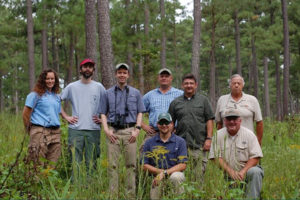This post provides links for those who wish to explore more fully the past 11 years of what we now call our “Quail and Early-Successional Species Recovery Initiative.” In our 2017 evaluation and revision of our program, we drafted a comprehensive report that not only graded our efforts to date but provided a path forward. Note that the path forward was under ideal conditions and did not include budget cuts, position vacancies, and a global pandemic.
Our quail plan emphasized private lands work in targeted sections of the state, but our team helped any and all landowners in all counties, whether targeted or not. Over my career, which now approaches 25 years, I have found maintaining focus on specific counties or regions to be difficult through time. I have also found that predetermined areas do not always work out to be best, and am beginning to believe that focus areas should be expanded where they develop on their own due to local interest.
Every year, our team has also prepared a report and summary of the past year’s efforts. This special 10-year edition focuses on our private lands work. It is as much a “human” overview as it is facts and figures. All too often, we forget the human element of our work, which, in the end, is most important. Special thanks to Scott Klopfer, director of the Conservation Management Institute (CMI) of Virginia Tech, for his work on this 10-year Bulletin. Without Scott, and CMI, this report would not be in its current format and we would not have this link to it. Scott’s and CMI’s services to so many entities in the wildlife profession often go unheralded. Our quail team and the past 11 years of our work would not have been possible without Scott and CMI. We recognize all our partners in the reports provided, without whom we would fail.

Multiple states have enacted “quail plans” over the past decades and have met with varying degrees of success. Ours is no different. Some have focused more on public lands and research, others have concentrated on particular Farm Bill programs. Common to all these efforts are the ebbs and flows of funding and interest among agency and partner leadership. Occasionally those things align, and funding, agency leadership, and partner interest drives a wave of quail work. I want to thank the leadership of our own agency, the Department of Wildlife Resources (DWR), for continuing to support our efforts over 11 years. We have become so much more than simply a “quail plan.”
With regards to private lands, our team’s efforts have benefited butterflies, bees, and songbirds as much or more than bobwhites. We have also worked hard on some of our public lands. Most notably on our NBCI Coordinated Implementation Program Focal Area. Our Big Woods/Piney Grove focal area in southeastern Virginia is a partnership between the DWR, the Nature Conservancy, and the Virginia Department of Forestry. It is a national red-cockaded woodpecker (RCW) management unit, having the most northern population of RCWs in their range. It is a work in progress for quail and is improving every year. Just last week, the Big Woods Management Area Supervisor, along with two of us quailophiles, completed spot spraying of encroaching sweetgum on our logging deck renovation project there. And much work has also been done on our northern Virginia focal area Manassas National Battlefield Park. Surrounded by an ever growing suburbia, the team at Manassas is still able to maintain and increase quail numbers on the park.
As an agency bound by our mission to serve multiple constituencies, it is difficult to dedicate any entire wildlife management area (WMA) to one cause or species. And we have been unable to dedicate any of our WMAs solely to quail management. That said, our WMA staff have done an outstanding job of incorporating early-successional habitat management on their WMAs. With 44 WMAs totaling nearly 220,000 acres, they have a big job with a lean number of staff. There has been an increasing interest in properly applying prescribed fire on our lands. And no single management technique can treat as many acres as quickly and at as low a cost as can prescribed fire. There is a new level of interest in the professional development required to allow our staff to up our ability to manage with fire through time.

Like many agencies, ours is seeing an increase in the retirements of long-term staff. They take with them a lifetime of knowledge that is hard to replace. But from my perspective, I am excited by the enthusiasm and level of knowledge I see in their young replacements. Time goes on, and older generations make way for newer ones. I am enormously proud of the wildlife work done by my generation and the ones before it. But I am equally optimistic that this younger generation, while perhaps not doing things exactly as we would have, will do things extremely well… and most likely, better than we did.
My first hand experiences hunting our public lands in central Virginia have convinced me that upland bird hunting is alive and well in Virginia. I am also optimistic that we are seeing a modest resurgence in our quail population in some areas. The work to do will never end, though. Quail recovery will span my career and the careers of several more generations to come. Our team will continue to do all we know how to do, and all we have the means to do, as long as we can do it to promote the development of the habitats used by bobwhites, rusty-patched bumble bees, Monarch butterflies, brown headed nuthatches, wild turkeys, golden-winged warblers, rabbits, red-cockaded woodpeckers, deer, and grouse. Regardless under which species name the work is done, the results are for the good of all.


